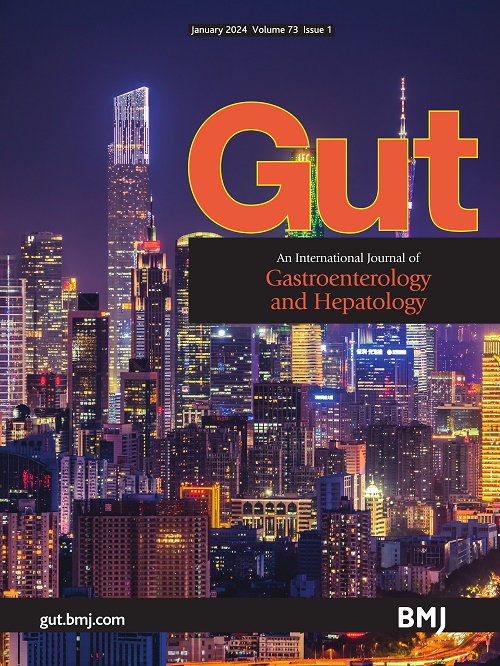在一项大型欧洲多中心队列研究中,血栓反应蛋白-2是一种有效的危险MASH和晚期MASH纤维化生物标志物
IF 25.8
1区 医学
Q1 GASTROENTEROLOGY & HEPATOLOGY
引用次数: 0
摘要
背景:需要具有生物学原理的非侵入性生物标志物来识别进行性代谢功能障碍相关脂肪性肝炎(MASH)患者。目的探讨肝转录组学检测的与MASLD严重程度相关的血小板反应蛋白-2 (TSP2)、胰岛素样生长因子结合蛋白-7 (IGFBP7)、生长分化因子(GDF15)和CD163的诊断价值。设计:对欧洲三个中心疑似MASLD的肝活检患者进行回顾性研究。elisa法检测TSP2、IGFBP7、GDF15、CD163。肝脏刚度(振动控制瞬态弹性图,VCTE)、FIB4、Agile3和FAST评分作为比较。结果是高危MASH (ARM, NAS脂肪性肝炎bbbb4和纤维化2-4期)和晚期纤维化(AF, 3-4期)。组合评分包括纤维化生物标志物和临床/生物学变量,使用多变量逻辑回归控制中心、年龄、体重指数(BMI)和性别。训练集和验证集使用机器学习算法定义,该算法对总队列进行随机分割,进行100次迭代,并对接收者工作特征曲线(AUROC)预测下的面积进行平均。结果共纳入469例患者,男性占61%,平均年龄51.4岁,BMI 30.6 kg/m²,2型糖尿病占44%,高血压占54%,AF占31%,ARM占46%。AF的TSP2 AUROC为0.812 (95% CI: 0.766 ~ 0.859),高于其他生物标志物(范围为0.680 ~ 0.769,p<0.001)和比较物(VCTE: 0.739, p<0.04;FIB4: 0.726, p<0.01; Agile3: 0.755, p=0.20)。ARM的TSP2 AUROC为0.812 (95% CI: 0.758至0.858),高于其他生物标志物(范围为0.722至0.748,p<0.001)和比较物(FAST: 0.761, p=0.17)。将TSP2与临床/生物学变量(AST、年龄、血小板、白蛋白、GGT)结合使用,AF的auroc增加至0.846 (95% CI: 0.807至0.885),ARM的auroc增加至0.845 (95% CI: 0.806至0.880),显著优于所有其他生物标志物。结论血清TSP2单独或结合临床/生物学变量,可有效区分MASLD患者AF和ARM。所有与研究相关的数据都包含在文章中或作为补充信息上传。本文章由计算机程序翻译,如有差异,请以英文原文为准。
Thrombospondin-2 is a performant biomarker of at-risk MASH and advanced MASH fibrosis in a large multicentre European cohort
Background Non-invasive biomarkers with biological rationale are needed for identifying patients with progressive metabolic dysfunction-associated steatohepatitis (MASH). Objective To test the diagnostic performance of thrombospondin-2 (TSP2), insulin-like growth factor binding protein-7 (IGFBP7), growth differentiation factor (GDF15) and CD163, which were identified by liver transcriptomics as associated with the severity of MASLD. Design Retrospective study from three European centres in patients with liver biopsy for suspected MASLD. TSP2, IGFBP7, GDF15 and CD163 were measured by ELISAs. Liver stiffness (vibration controlled transient elastography, VCTE), FIB4, Agile3 and FAST scores served as comparators. Outcomes were at-risk MASH (ARM, steatohepatitis NAS>4 and fibrosis stages 2–4) and advanced fibrosis (AF, stages 3–4). Combinatorial scores included fibrosis-biomarkers and clinical/biological variables using multivariate logistic regression controlling for centres, age, body mass index (BMI) and gender. Training and validation sets were defined using a machine learning algorithm with a random split of the total cohort, for 100 iterations, and averaging of area under the receiver operating characteristic curve (AUROC) predictions. Results 469 patients, 61% males, mean age 51.4 years, BMI 30.6 kg/m², 44% with type 2 diabetes, 54% with hypertension, 31% with AF and 46% with ARM were included. The TSP2 AUROC for AF was 0.812 (95% CI: 0.766 to 0.859) higher than for the other biomarkers (ranging from 0.680 to 0.769, p<0.001) and for the comparators (VCTE: 0.739, p<0.04; FIB4: 0.726, p<0.01 and Agile3: 0.755, p=0.20). The TSP2 AUROC for ARM was 0.812 (95% CI: 0.758 to 0.858) higher than for other biomarkers (ranging from 0.722 to 0.748, p<0.001) and comparators (FAST: 0.761, p=0.17). Combining TSP2 with clinical/biological variables (AST, age, platelets, albumin, GGT) increased AUROCs to 0.846 (95% CI: 0.807 to 0.885) for AF and 0.845 (95% CI: 0.806 to 0.880) for ARM and was significantly more performant than all other biomarkers. Conclusions Serum TSP2, alone or with clinical/biological variables, potently discriminates AF and ARM in patients with MASLD. All data relevant to the study are included in the article or uploaded as supplementary information.
求助全文
通过发布文献求助,成功后即可免费获取论文全文。
去求助
来源期刊

Gut
医学-胃肠肝病学
CiteScore
45.70
自引率
2.40%
发文量
284
审稿时长
1.5 months
期刊介绍:
Gut is a renowned international journal specializing in gastroenterology and hepatology, known for its high-quality clinical research covering the alimentary tract, liver, biliary tree, and pancreas. It offers authoritative and current coverage across all aspects of gastroenterology and hepatology, featuring articles on emerging disease mechanisms and innovative diagnostic and therapeutic approaches authored by leading experts.
As the flagship journal of BMJ's gastroenterology portfolio, Gut is accompanied by two companion journals: Frontline Gastroenterology, focusing on education and practice-oriented papers, and BMJ Open Gastroenterology for open access original research.
 求助内容:
求助内容: 应助结果提醒方式:
应助结果提醒方式:


